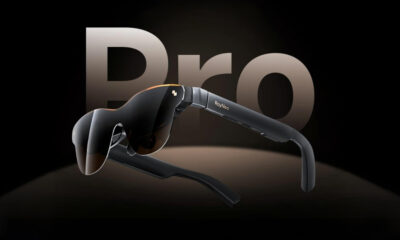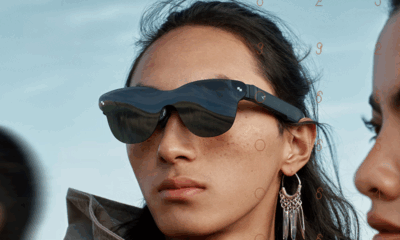News
What’s So Special About the RayNeo Air 3s Pro?
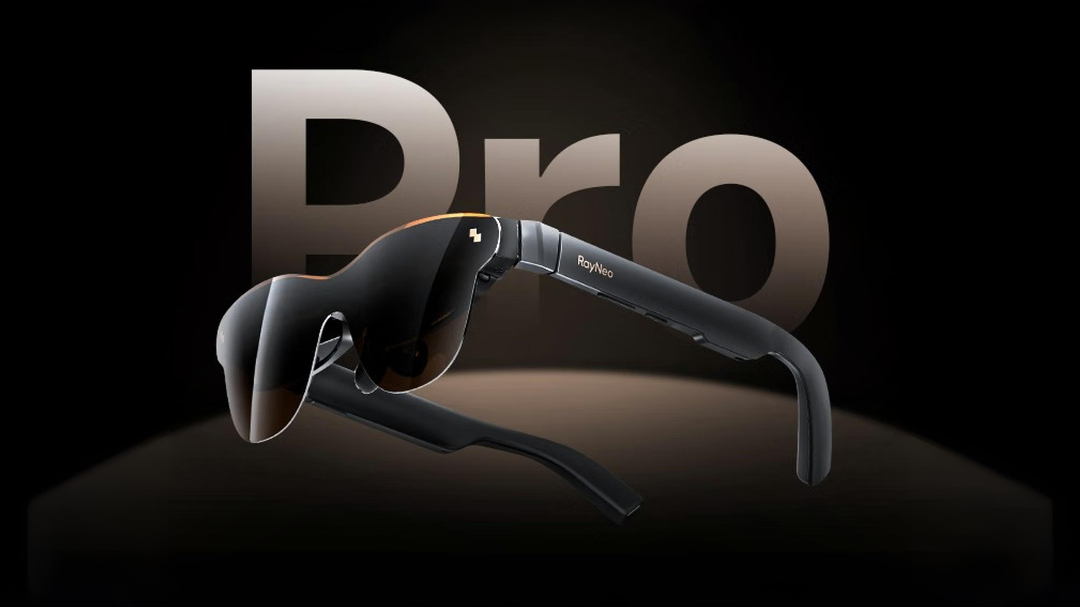
RayNeo has launched the Air 3s Pro AR glasses, a follow-up to the original Air 3s. This model enhances several key features while keeping the price lower than the previous version. With a launch offer of $249, the Air 3s Pro improves visual quality, audio immersion, and comfort without overcomplicating the design or setup.
Brighter, Bolder, and Built for Outdoors
The Air 3s Pro steps up the brightness to 1,200 nits, nearly double the 650 nits on the Air 3s. This jump has a noticeable impact in bright environments. Content appears sharper in sunny conditions, and dark scenes with bright elements like stars show higher contrast and greater clarity.
The display uses the HueView 2.0 Micro OLED engine with a tandem OLED structure. This improves edge sharpness, contrast ratio (200,000:1), and overall energy efficiency. Color accuracy also improves with 98% DCI-P3 coverage and △E<2 precision. RayNeo includes new viewing modes like Vision Boost for outdoor use and Eye Protection for long sessions.
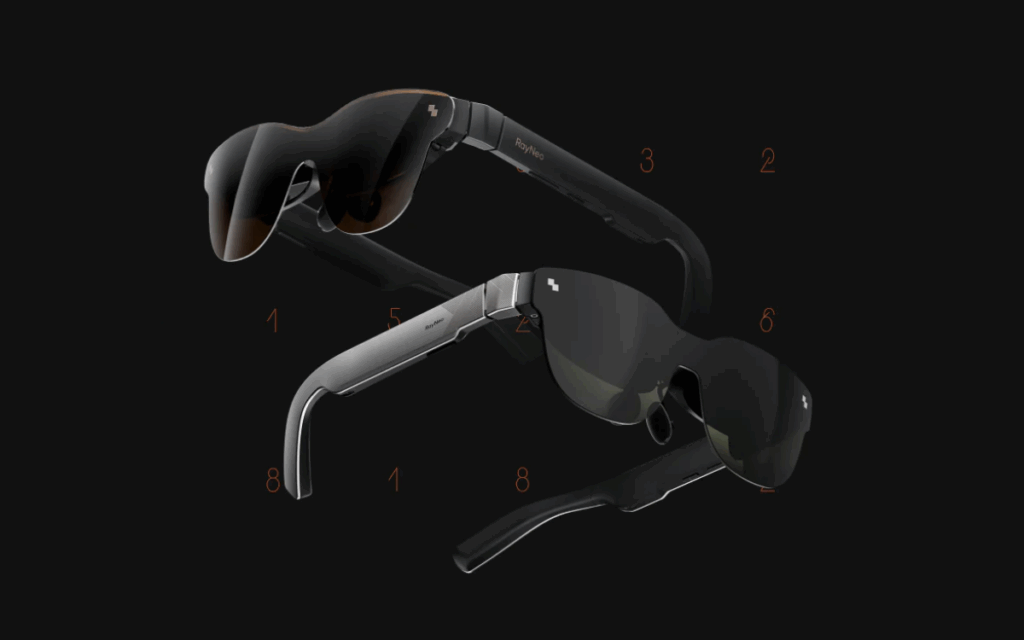
It’s What’s on the Inside (and the Outside)
The design stays nearly identical to the original model, but the internals tell a different story. The updated optical engine reduces glare by 15% and sharpens visuals across the entire field of view. Ghosting and color fringing are less noticeable.
The glasses weigh 76 grams like the original, but they now use a refined weight balance with 46.7% front and 53.3% rear for better overall comfort. It also offers nine levels of temple adjustment and three levels of nose pad positioning. The fit works better across different head shapes without increasing pressure.
Whisper Mode Gets Louder… Privately
The quad-speaker system on the Air 3s Pro remains compact but now supports spatial audio. It delivers a more directional and immersive sound experience, useful for watching movies or playing games. RayNeo’s Whisper Mode continues to minimize audio leakage. Sound remains clear even in shared environments like cafes or flights.
Vocals have improved clarity, and background effects maintain separation. The speakers are placed in dual acoustic chambers for a fuller stereo image. This upgrade gives the Pro a stronger edge for media consumption without requiring headphones.

Familiar Looks
The Air 3s Pro looks nearly identical to the 3s. The only noticeable difference is the uniform black finish, which replaces the two-tone silver and black design on the earlier model.
RayNeo ships the Pro with a new triangular soft-shell case. It feels nicer to the touch and resembles a traditional sunglasses pouch. However, the original hard-shell case provides better structural protection and includes a pocket for storing cables. The new case saves some space but doesn’t feel as secure inside a backpack.
Broad Compatibility, Now Switch 2 Ready
RayNeo retains the same wide device compatibility. The Air 3s Pro connects via USB-C to smartphones, tablets, laptops, and handheld consoles that support DisplayPort Alt Mode. It also works with HDMI adapters for legacy devices.
The Pro adds support for the upcoming Nintendo Switch 2 when paired with RayNeo’s updated JoyDock. This improvement expands the use case for portable gaming. Support for Steam Deck, PS5, and Xbox also remains available through HDMI to USB-C adapters.
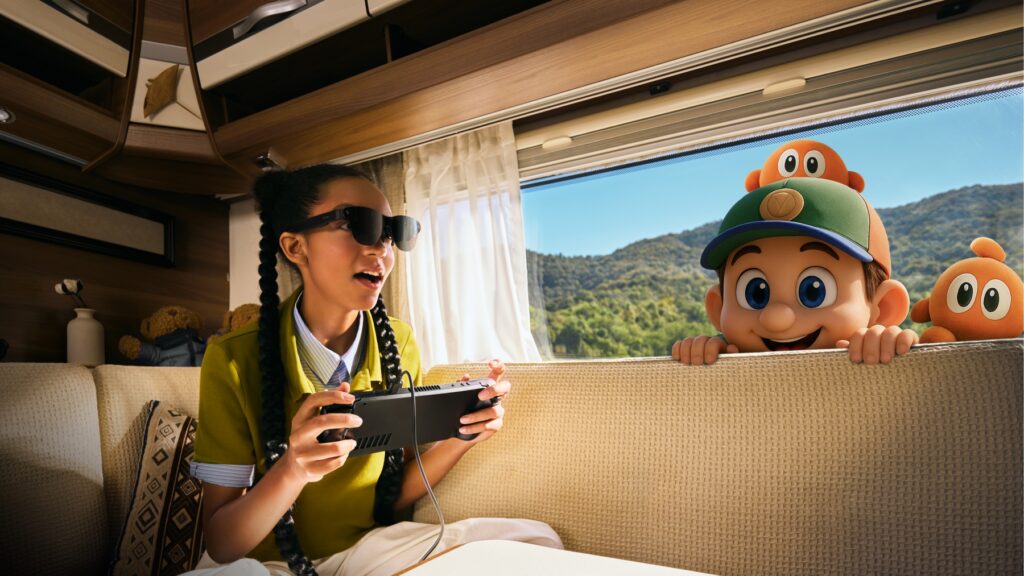
The Best Just Got Cheaper
Despite several meaningful upgrades, the Air 3s Pro costs less than the Air 3s at launch. The $249 price includes an auto-applied coupon, making it one of the most affordable AR glasses with high-end display and audio features.
The Air 3s Pro improves display brightness, reduces visual strain, enhances audio privacy, and adds compatibility features, all while lowering the barrier to entry. This version does not reinvent the formula but refines nearly every core component, making it a smarter buy whether you’re new to AR glasses or looking for a better upgrade path.
Buy Now From RayNeo Official Website
We’ve also covered the RayNeo Air 3s Pro vs RayNeo Air 3s in detail; don’t miss that breakdown if you’re deciding between the two.
News
TCL A400 Pro QD-Mini LED Art TV launched with 4K 144Hz display

TCL has launched the A400 Pro QD-Mini LED Art TV in the Chinese market. It aims to blur the line between display technology and interior design.
TCL A400 Pro Specifications
Since this is part of TCL’s Art TV series, design takes center stage. The screen sits inside a light walnut-textured frame with no visible seams, thanks to a single-piece bending process. It stays incredibly slim at just 3.99 cm for up to 75 inches and 4.45 cm for the 98-inch version.
The rear panel takes on a textured finish inspired by vintage hardbound books. TCL supports three placements: a slim wall bracket for a flush mount, a two-stage desktop stand, and an optional mobile floor mount with wheels.
On the performance side, the A400 Pro uses TCL’s QD-Mini LED tech with independent zone dimming and Quantum Dot Pro materials that cover 157% of the BT.709 gamut. It supports native 4K at 144Hz, plus 288Hz output in Game Mode. There’s also VRR, ALLM, and AMD FreeSync Premium Pro baked in.

TCL backs the visuals with the TSR AI engine, which tunes color, clarity, and motion frame by frame. The screen also adjusts brightness automatically using an ambient light sensor.
In Art Mode, the TV doubles as a digital canvas. It includes over 100 curated artworks and can generate original pieces using AI. It runs on Lingkong OS 3.0, skips boot ads, and uses the Fuxi AI model to power 18+ smart assistants for gaming, fitness, education, and more.
Pricing and Availability
The TCL A400 Pro is available in five sizes, with pricing that scales across the lineup. The 55-inch model starts at 7,999 yuan (about $1,120), while the 65-inch version is priced at 10,999 yuan (about $1,540). The 75-inch variant costs 12,999 yuan (about $1,820), the 85-inch model comes in at 14,999 yuan (about $2,100), and the top-end 98-inch version is priced at 19,999 yuan (about $2,800).
In related news, RayNeo’s Air 3s Pro AR glasses dropped to $249 during the Black Friday sale, and TCL’s T7 4K QLED Smart TV continues to draw attention for its feature set and performance in the midrange segment.
Deals
RayNeo Air 3s Pro AR Glasses Drop to $249 in Black Friday Deal

RayNeo’s latest smart AR glasses, the Air 3s Pro, are now hitting their lowest price ever for Black Friday 2025. Originally launched at $299 in August, the Air 3s Pro has dropped to $249 on the official website. The 17 percent discount runs through December 1 as part of a limited-time flash event.
The Air 3s Pro takes RayNeo’s XR vision further with a brighter and bolder display experience. It delivers a 201-inch virtual screen at 6 meters away, backed by HueView 2.0 Micro-OLED tech that pushes 1,200 nits brightness and a contrast ratio of 200,000:1. Color coverage reaches 98 percent DCI-P3, with six viewing modes that include Game, Movie, Eye Protection, and Vision Boost for different content types.
RayNeo includes OptiCare 3840Hz PWM dimming technology, TÜV-certified eye comfort, and 20-step brightness control to reduce strain. These features make the glasses suitable for binge sessions. On the audio front, a quad-speaker array with Whisper Mode 2.0 delivers spatial audio with privacy, suitable for commuting or late-night viewing.
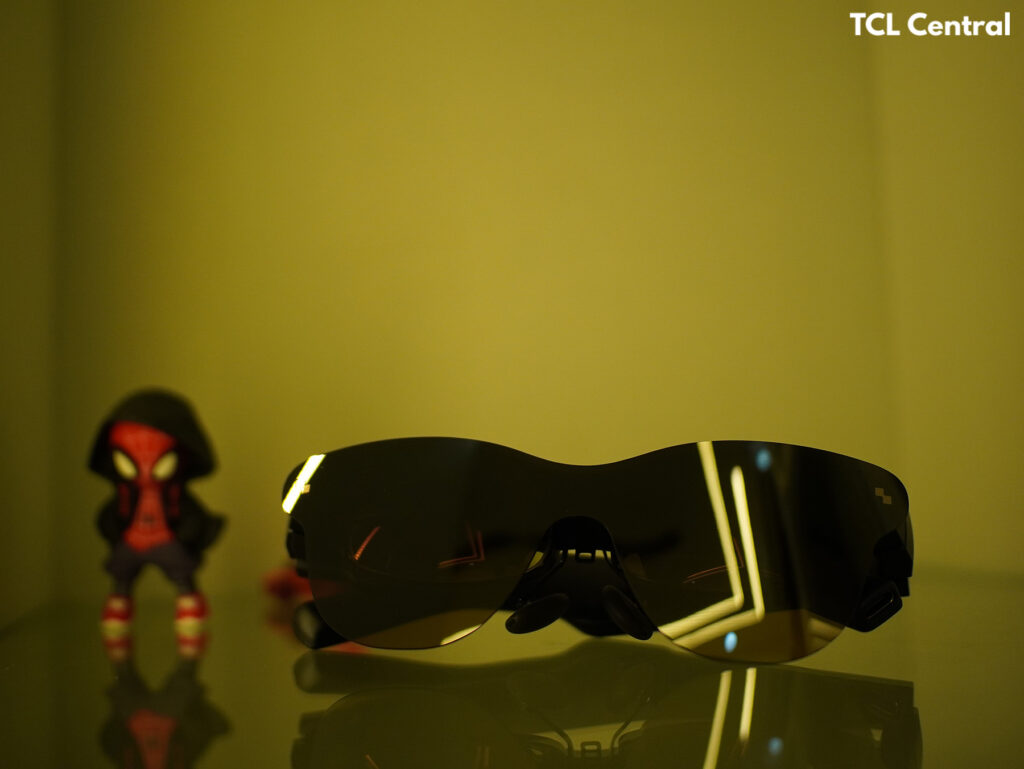
At just 76 grams, the glasses feature a carefully balanced front and rear weight distribution. They include flexible temple and nose pad adjustments for improved comfort. The Air 3s Pro connects via USB-C, HDMI, or accessories like JoyDock. It supports iPhones with DockKit, Android phones, gaming consoles such as Switch, PS5, Xbox, and also PCs.
Compared to its predecessors, the Pro model improves display brightness, color accuracy, and audio immersion. Whether watching YouTube, streaming Netflix, or playing a Switch game, the Air 3s Pro feels like a private IMAX you can wear.
RayNeo now offers one of the most full-featured AR glasses at its best price yet. For anyone considering a jump into XR, this may be the right time.
Buying Guides
What’s So Special About TCL T7 4K QLED Smart TV?
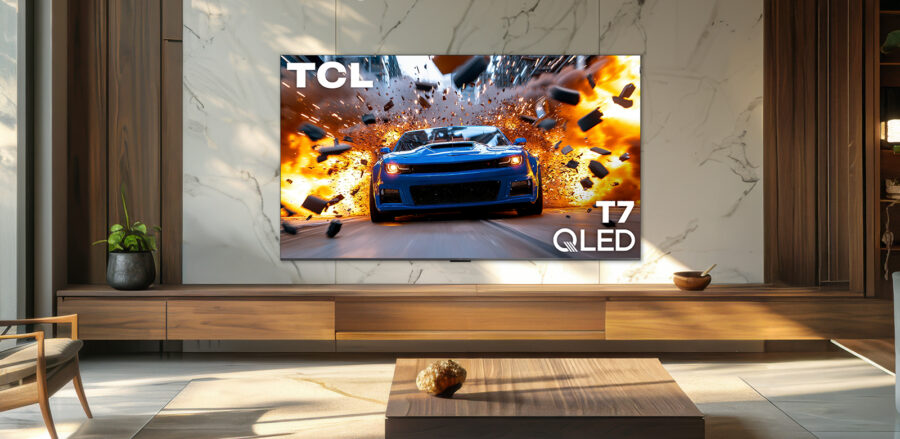
TCL has recently launched the TCL T7 4K QLED Smart TV series as its latest mid-range television lineup. The series includes 4K UHD resolution, QLED panels, high refresh rates, and Google TV integration. TCL positions the T7 as a premium entertainment and gaming TV that targets mainstream buyers without pushing the price too high.
Premium Looks Meet Sensible Design
TCL uses a bezel-less design across all T7 models. The TVs feature a minimalist look that suits wall mounting or table placement. TCL includes adjustable-width feet to allow more flexibility for setups with soundbars or compact entertainment units. This small design choice improves usability, especially in tighter spaces. Despite falling in the mid-range category, the T7 models look refined and clean.
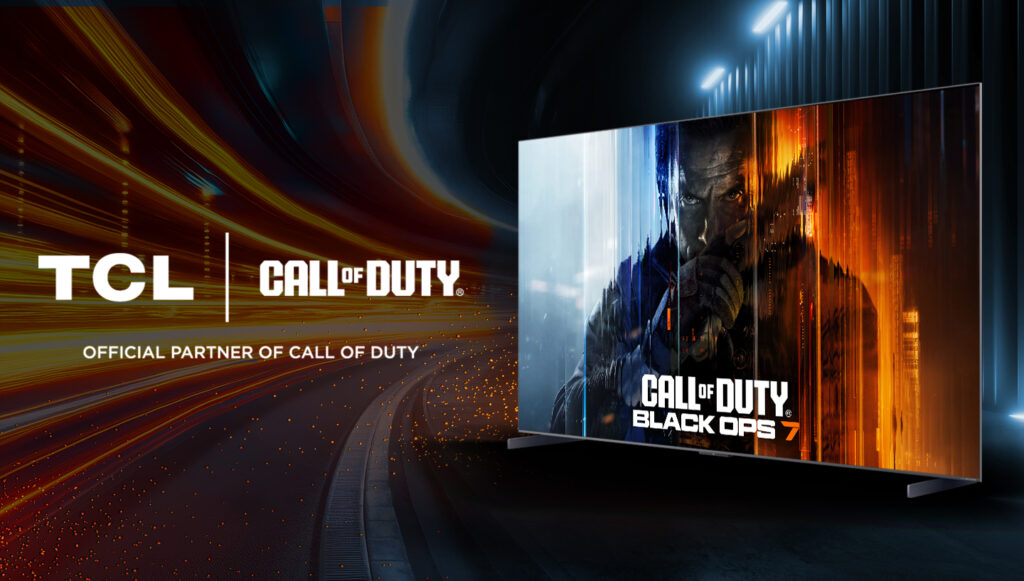
QLED Visuals With 144Hz Sweetness
All four models in the T7 lineup support 4K resolution at 3840 × 2160. The 55-inch variant uses a 120Hz panel, while the 65, 75, and 85-inch versions move up to a native 144Hz refresh rate. This high refresh rate improves fast-motion clarity in games and sports content.
TCL adds support for variable refresh rate (VRR), Auto Low Latency Mode (ALLM), and Game Accelerator. The 85-inch model can reach up to 288 VRR, which helps reduce input lag during gameplay. These features make the T7 Series suitable for console and PC gamers who want smoother motion and lower latency.
All the HDR Formats You Could Ask For
TCL supports a wide range of HDR formats on the T7 Series. Each model handles Dolby Vision, HDR10+, HDR10, HLG, and Open HDR. This broad compatibility allows content from most major streaming platforms to play in the intended HDR format.
The AiPQ Pro processor powers TCL’s picture enhancement. It adjusts image settings in real time to boost contrast, color accuracy, and detail sharpness. The QLED panel supports 1.07 billion display colors and uses a high-brightness LED backlight to improve image clarity in bright environments.

Smarter, Louder Smart TV
The T7 Series runs on Google TV. This platform gives access to thousands of apps and services, including Netflix, YouTube, and Disney+. Built-in Chromecast and Apple AirPlay 2 support allow wireless casting from Android and iOS devices.
TCL adds far-field microphones to all T7 models. This allows voice control without using the remote. The TVs also support Google Assistant, Amazon Alexa, and Apple HomeKit for smart home control. TCL includes a backlit voice remote and ships the unit with AAA batteries.
The 55-inch, 65-inch, and 75-inch models include a 2.0-channel speaker system, ranging from 20W to 30W. The 85-inch model features a 2.1 Onkyo speaker system with a built-in subwoofer and a total output of 40W. All models support Dolby Atmos and Dolby Digital+ formats to enhance spatial audio.
Ports, Power, and Peace of Mind
TCL includes four HDMI ports on each T7 TV, with one port supporting eARC. The TVs also come with USB 3.0 and USB 2.0 ports, Ethernet input, optical digital audio out, and RF input for antenna or cable. Wireless connectivity uses Wi-Fi 5 (802.11ac).
Other included features are sleep timer, multilingual on-screen display, closed captions, JPEG/MP3 playback from USB, and accessibility options. Power consumption remains under 0.5W in standby mode. The TVs do not carry Energy Star certification. Each model supports VESA wall mounting.
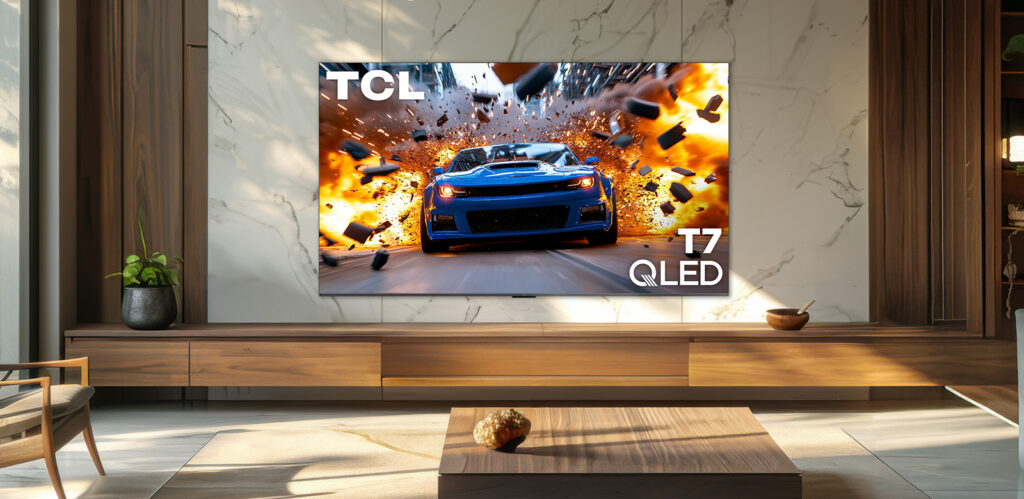
Value Without Compromise
TCL prices the 55-inch T7 at $599.99. The 65-inch model costs $699.99, the 75-inch version is listed at $899.99, and the 85-inch model comes in at $1,399.99. These prices make the T7 Series competitive in the mid-range segment. TCL has not announced a specific release date, but availability is expected by the end of the year.
The T7 Series checks many boxes for buyers who want a high-performance smart TV without entering the premium OLED or Mini LED space. With QLED visuals, 144Hz gaming support, advanced HDR compatibility, and solid audio options, the T7 Series stands out as a complete and well-rounded offering in its price class.
In related news, TCL CSOT showcases its printed OLED, Micro LED, MLED, and tri-fold display technologies at DTC2025, and TCL leads Double 11 TV sales once again as it strengthens its premium position with SQD Mini LED technology.

